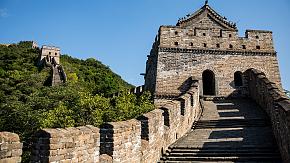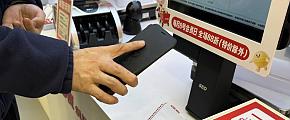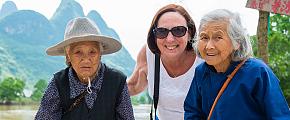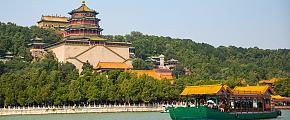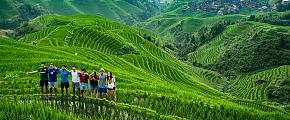All You Need to Know about Mid-Autumn Moon Festival
The Mid-Autumn Festival (Moon Festival, or Mooncake Festival) is one of the most important traditional festivals observed in China, occurs to worship the visible and bright full moon in the night sky. It is a precious time for family gatherings and includes many fascinating traditions, like worshiping the full moon and eating mooncakes. Today we will provide you with all the information you need to know about the Moon Festival in China, from its origin to various time-honored traditions worth trying during your autumn China tour.
When Is the Chinese Mid-Autumn Festival in 2025
The Chinese Mid-Autumn Festival falls on October 6, 2025, the 15th day of the eighth month in the Chinese calendar usually takes place in September or October.
| Year | Date |
| 2025 | October 6, Monday |
| 2026 | September 25, Friday |
| 2027 | September 15, Wednesday |
| 2028 | October 3, Tuesday |
Why Is the Mid-Autumn Festival Celebrated
The Moon Festival has a long history, dating back to the Tang Dynasty (618–907 AD). It is derived from ancient Chinese worship of celestial bodies of the sun, moon, and stars.
In ancient agricultural society, it was believed that the moon and the sun made a big difference in seasonal change and farming, so moon worship has been an extremely important ritual in Chinese culture, to show their awe and veneration of nature with the joy of plentiful harvest. The Mid-Autumn Festival evolved from such a ritual act.
According to the Chinese lunar calendar, autumn falls on lunar July, August, and September. Since the worship takes place in lunar August, in the middle of autumn, the festival is folklorically named Mid-Autumn. With major events and rituals in this period revolving around the full moon, the festival is also called the Moon Festival.
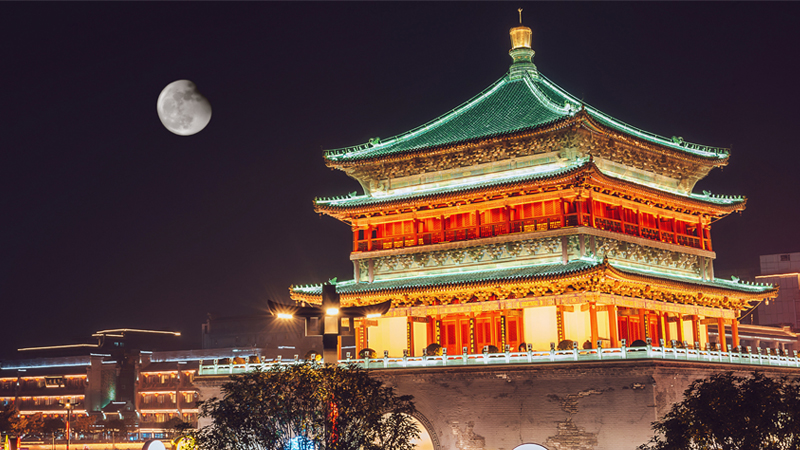 Night View of the Moon Festival
Night View of the Moon Festival
What Is the Story of the Mid-Autumn Festival
Chinese people worshiping the moon at the Mid-Autumn Festival is seen as a plain way to express their wishes for longevity, blessing, and reunion. Such wishes are attributed to many ancient myths and legends about the Moon Festival which have been widely disseminated throughout history.
There is a household legend about Wu Yan, an ugly woman who was loved by the king and became his empress due to her pious moon worship on the night of mid-autumn. Another is about Chang'e, who became a god by accidentally swallowing the elixir and flying to the moon, finally reuniting with her husband, Hou Yi on the evening of August 15th every year.
Whether the success of Wu Yan or the eternity of Chang'e, these legends are an essential part of the Mid-Autumn Festival that prompts Chinese people to place hope in the worship of the moon.
How Is the Mid-Autumn Festival Celebrated
Reuniting With Family
The full moon symbolizes togetherness. As the crescent finally turns into a full moon, homesick family members will finally be reunited like the pieces of the crescent. So the Mid-Autumn Festival has become a significant time for all Chinese people to sit with family members and share a feast.
Usually on this day, the Chinese, especially young strangers who struggle for their own careers or study outside the home, will come back home to have a substantial reunion dinner with their family. This is a precious time for young people to accompany family members and recount their own experiences outside.
Worshiping the Moon
Moon worship is an integral part of the Chinese Mid-Autumn Festival. Locals worship the moon and their gods piously with burning incense to pray for a happy reunion and good luck.
In most areas, the Chinese worship the moon with offerings, including incense, red candles, mooncakes, fruits, tea, and the like, on the tables. It is often held at the home of the eldest member of the family. Usually, there are scores of families making the pilgrimage together in a public place, while some families do that on their own balconies.
Appreciating the Moon
Moon appreciation is another important tradition among the Chinese family during the Mid-Autumn Festival. The full moon means reunion and wealth, so the family sitting together to admire the full moon at the festival is also a kind of blessing for the long reunion.
With a long tradition of the moon feeling, Chinese people also used to relieve the feeling of homesickness if they were in a strange land, or missing their unreturned families while admiring the full moon. The Chinese, no matter whether in ancient times or at present, always look up unconsciously at the moon on festival nights.
Eating Mooncakes
Eating mooncakes is one of the most significant traditions on the day of the Mid-Autumn Festival. Popularly, just like the full moon, round-shaped mooncakes also represent togetherness and harmony, with various flavors from salt to sweet.
On the night of the festival, Chinese families will enjoy mooncakes together after worshiping the moon. They can also be the main dessert after the reunion dinner, usually accompanied by tea, the best match during the moon appreciation. Today, mooncakes are widely used as a gift for families and friends during the Moon Festival.
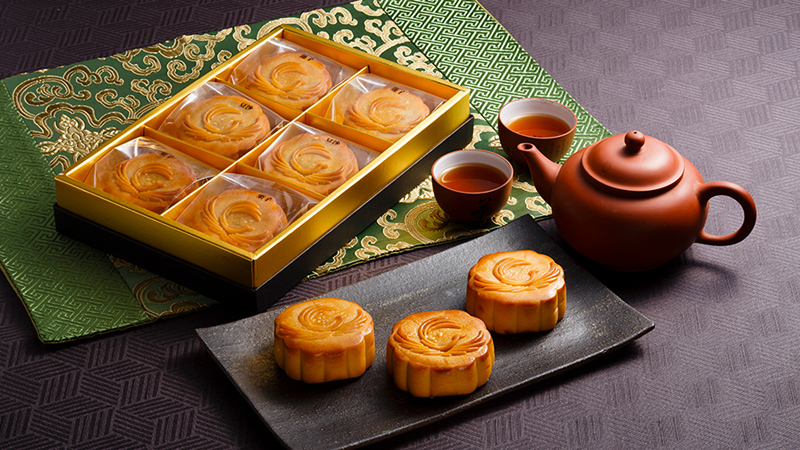 Chinese Mooncakes
Chinese Mooncakes
Releasing & Playing With Lanterns
Like the Lantern Festival at the beginning of spring, lanterns also play an important role in the Mid-Autumn Festival. Lantern vendors would fill parks and streets, and many shops were decorated with colorful lanterns.
For thousands of years, Chinese people would write wishes or lines on lanterns and release them into the sky, hoping gods would accept their aspirations. Now battery-powered lanterns are more and more widely accepted. You can watch the lantern procession in which children and adults carry lanterns of various shapes and sizes through the streets, creating a colorful and festive atmosphere.
What to Eat and Drink During the Moon Festival
Mooncakes
Symbolizing harmony and unity, mooncakes are thought to be the most important food of the Mid-Autumn Festival. You can get different types and flavors of mooncakes in dim sum shops and restaurants.
The traditional one is made with lotus seed paste and salted egg yolk, or a Wuren mooncake filled with almond, olive, peach, black melon, and sesame seeds. There are also popular modern versions like ice cream mooncakes, filled with chocolate cream or other fruit fillings. Too many mooncakes may be a bit greasy so it's a good idea to counter the grease by drinking some tea or wine.
Osmanthus Wine & Pastries
The Mid-Autumn Festival coincides with the blooming of sweet-scented osmanthus. The Osmanthus flower is known as Laurus nobilis in China.
China has a long tradition of making osmanthus wine and pastries. Osmanthus wine has a delicate fragrance and a tiny sweet taste. Osmanthus pastries such as osmanthus cake and candy are another traditional food at the festival. There are many types of osmanthus pastries with different fillings like sesame, jujube paste, and smashed bean to choose from. You can get such wine and pastries at many stores and shops during the festival.
Ling Kok (Water Caltrops)
Water caltrops, sometimes known as water chestnuts, usually ripe a few weeks before the festival, are a traditional dish specially used in the Mid-Autumn Festival.
The water caltrops are usually cooked in freshwater as snacks or cooked into gruel. The shape of water caltrops is considered to resemble a bat, an auspicious symbol of fortune and luck because the bat's Chinese character sounds similar to the word "福" (fú), making a folk custom that people who eat water caltrops will become bright and have good luck in the future.
Grapefruit
Grapefruit is a seasonal food during the Mid-Autumn Festival, and it is a popular offering in moon worship. Grapefruit has the moon in shape, and in Chinese, the character for grapefruit is homophonous with the word "佑" (yòu), which means the moon and gods would bless worshippers.
It's common to bring grapefruit as a gift to relatives and friends during the festival. This fruit is well suited to counter the grease in too many mooncakes and has many healthy effects.
Where to Celebrate the Mid-Autumn Festival in China
Most of China cities will be decorated exquisitely with beautiful items about the romantic story of Chang E including cute rabbit lanterns and Chang E flying to the moon. Here, we list some cities where you can enjoy a festive atmosphere. You can keep curious while strolling on the street during the moon festival and try to find some related decorations.
Planning your fall vacation to China and don't want to miss the moon festival? Why not choose a China itinerary as your reference, and contact us to customize your perfect China vacation in autumn?
Beijing - Traditional Moon Admiring
In Beijing, the Mid-Autumn Festival is celebrated with traditional activities. You can visit parks such as Jingshan Park and Taoranting Park to enjoy the festive atmosphere. One of the most popular parks is Beihai Park, a place where emperors admired the moon.
You can enjoy the beautiful moon reflected in the sparkling Taiye Pond or enjoy a lake trip while seeing the moon and eating mooncakes. In addition, various lantern shows will be held on Tiananmen Square, Fragrant Hills, or Long Tan Lake. You can enjoy watching colorful lanterns and playing riddles during the festival night.
Shanghai - Bustling Modern Nightlife
Shanghai is a bustling city with vibrant nightlife, and during the Mid-Autumn Festival, the city comes alive with lantern displays, fireworks, and performances.
Oriental Pearl TV Tower and Jin Mao Tower, offer a perfect view to appreciate the bright moon and a stunning city panorama. The famous Yuyuan Garden is a great place to experience the festival atmosphere. A great number of vendors are decorated with traditional lanterns and kites. There are many large exhibitions of classic handicrafts and art. You can see a wide range of delicious Chinese foods, wines, pottery, porcelain, and decorations.
Guilin - With Tranquil Moon Reflection
Guilin is famous for the beauty of its mountains and rivers. The fascinating natural landscape is an excellent background for moon reflection.
Elephant Trunk Hill is a classic place to admire the moon. The clear reflection of the moon in the river has a beautiful view to offer. In Water-Moon Cave, you can see an extraordinary sight of three moons: one hangs elegantly in the sky, and the other two lie on the water. What's more, it's nice to take a floating bamboo raft to watch the moon along the Li River to get a better look at the magical scene.
Travel to China in Autumn With Odynovo
The Mid-Autumn Festival is an important event tied together by Chinese commonly held beliefs. It expresses the Chinese wishes for family and national reunions, and even for the universal community around the world. Travel to China with Odynovo during the Moon Festival and participate in the unique cultural experience. If you have any questions about your travel plans, please get in touch with us at [email protected] .
Quick Question
What Our Clients Say
Explore the latest verified reviews of Odynovo's travel services on Tripadvisor, Google, Trustpilot, Product Review and more trusted platforms.
SUBSCRIBE TO WIN A FREE TOUR
Subscribe to our newsletter for a chance to win a free 7-day tour to India! And more insider travel news, exclusive offers, and inspiration will be sent straight to your inbox. Check our previous newsletters and get some sparks.

